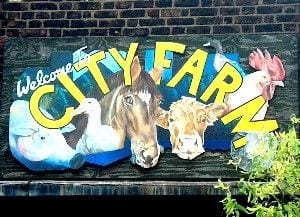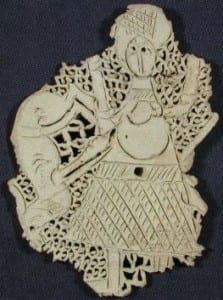Petrie Menagerie: The Petting Zoo
By Edmund Connolly, on 9 August 2013
Our menagerie has now gained two members which, by most standards, its not very many, so I am now going to throw in 4 more all under one child friendly umbrella: the Petting Zoo.
Petrie Menagerie #3 Domestic (including small and pick-up-able) Animals:
Thanks to the Nile, Egypt has areas of impressive fertility, granting the locals good crops and a regular cycle of irrigation and growth. In addition to arable produce, livestock were prevalent, including chickens, sheep and donkeys (and associated hybrids).
The Objects(s):
Given the prevalence of these creatures, it’s not surprising there are many representations of them:
I rather like this dexterous bull bronze, note its rather coquettish leg, neatly tucked under its abdomen, I have never seen a cow sit so gracefully. This piece would have also been a weight, suggested by its very flat bottoms so it could be rested securely; it is practical as well as pretty[1].
My favourite depiction of a docile and cuddle-able animal is this pottery sherd from the Fatimid period (second half of the 10th century AD) depicting a girl dancing with a hare[2].
As with the bull this piece has a practical function, being a water filter to fit in the neck of a pot. The hare is shown bounding in mid-motion, with incised lines around the forelegs and haunches denoting muscle movement, perhaps ready to spring. The female figure is wearing a hatched dress and headdress, with her raised arm suggesting she may be in some sort of dance or maybe ‘cult’ activity. Coupled with the image of the hare in motion, is this perhaps a dance between animal and human? The female figure seems to be touching the hare as they dance around in a circle.
Petrie’s Peers:
No official petting zoo was formally instated at London Zoo until 1938[3] (nearly 40 years after the Petrie museum was founded) under the title of a ‘Children’s zoo’. These animals granted a more intimate moment of contact between the public and exhibits which were designed to be touched and fed. But why farm animals, surely children wouldn’t care what a cow was, even less want to touch one? In the 19th century children of less affluent backgrounds and an urban upbringing may not actually have recognised some of these animals[4]. Would early 20th children be that different? Those who had been evacuated would have had a chance to see these animals in their arable landscape[5] and would be excited to return to the capital and see them in Regent’s Park.

Kentish Town city farm, a modern development of the petting zoo with the countryside truly established in an urban setting. copyright http://www.ktcityfarm.org.uk/
The countryside was another world, a world of English pastoralism not found in the smoggy London centre; the urban petting zoo allowed a new world to be injected right into the heart of a city.
The Menagerie:
There is a tenuous link between the Egyptian and Victorian on the theme of subject matter: similar domestic and small animals are being presented. More noticeable is the way in which the subject being contacted. Both animal and human are in direct physical contact, but perhaps on a more abstract level as well. Post WWI children may not have experienced these pastoral creatures until they were evacuated, thus their presentation in the centre of London perhaps offered a strand of continuity to their already shell shocked lives. The Egyptian girl dancing with her hare is touching the creature, but perhaps is involved with the animal on a spiritual level; the intricacy of their dance may suggest a more cerebral connection.
Well, that’s it for the petting zoo and a host of animals have joined our menagerie. Next week I am onto horses, including the first African horse and a feathered carousel horse who was made a couple of thousand years too early.
 Edmund works at the Petrie Museum of Egyptian Archaeology as the Projects Coordinator. He graduated from the Institute of Archaeology, UCL, in 2012 and plays sport for UCL almuni and ULU.
Edmund works at the Petrie Museum of Egyptian Archaeology as the Projects Coordinator. He graduated from the Institute of Archaeology, UCL, in 2012 and plays sport for UCL almuni and ULU.
[1] Although, best-animal-weight award goes to a sow-weight on display in the Pompeii exhibition at the British Museum, it’s so roguish!
[2] My mother’s favourite animal, my parents’ house is littered with star gazing hares
[3] http://www.zsl.org/about-us/history/
[4] Mayhew, London Rich and London Poor – a fascinating, albeit rather depressing read
[5] http://history.parkfieldict.co.uk/world-war-ii/evacuation
 Close
Close





